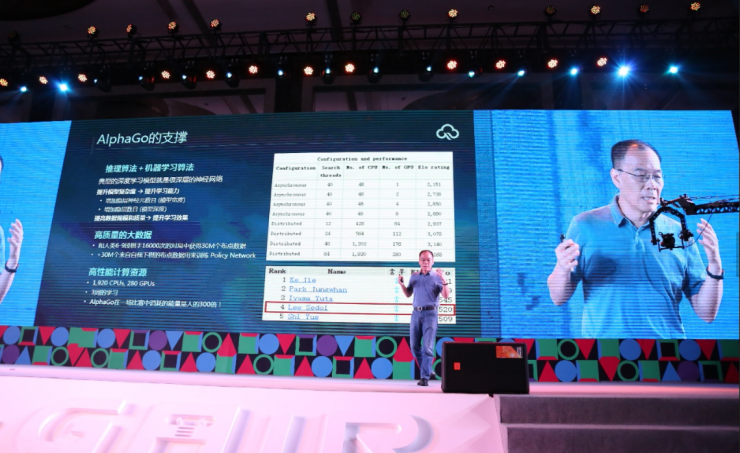
Lei Feng network (search "Lei Feng network" public concern) : This article is compiled from the CCF-GAIR global artificial intelligence and robotics summit, Jinshan software CEO and Jinshan cloud CEO Zhang Hongjiang speech.
Why did artificial intelligence have such rapid progress in the past few years, Zhang Hongjiang believes that this ultimately comes down to the progress of big data and the development of cloud computing.
AI support: data explosion
The progress of artificial intelligence is largely due to the progress of the data . Global consumption data will increase by 10 times in 2020, with an annual growth rate of 40%. Wechat will exchange 1 billion pictures in a circle of friends one day.
For example, Zhang Hongjiang: If you store photos of Xiaomi's users on the Xiaomi cloud, and if you have more than 500 million copies, you will need 1.2 million nuclei and need 100P of storage space. Today's stock photos in China are data for 2014. With 300 billion sheets, the amount of storage space and computation required is enormous.
20 years ago dream
The application on the mobile phone can perform a series of processing on face, face recognition and age judgment. This is not done by mobile phones, but in the cloud at the back of the phone. When the phone takes a photo, it is processed on the cloud, and the result is brought back. This is the dream of Zhang Hongjiang and his team 20 years ago.
In 1997, Zhang Hongjiang's team applied for a patent in HP Labs. This is a distributed architecture. The data is taken from the client and sent to the back-end system. A series of processes are performed to push the result to the front end. Come. Twenty years later, this matter can finally be realized on a mobile phone. More importantly, it can finally be realized in the cloud and on the end. The mobile phone becomes a data acquisition terminal, and the cloud serves as the carrier for the entire operation and the entire data.
The history of face recognition technology is the history of the expansion of face database. It is the history of face database + even the expansion of capabilities.
In the academic era, when face was made in the early 1990s, the database used in all academic eras had only a few hundred people's face pictures. Even in this case, the robot's recognition ability was still far below the recognition ability of the human being, and the light requirements were very high. High, need a positive image. In the industrial era, in 2014, the high-volume face recognition rate reached 97.35%, and in 2015 it reached 99.63%. At present, domestic companies add more than 70 million standard photographs and hundreds of millions of Other photographs. People use more than 30 deep-layer networks and train 20 NVIDIA. The accuracy has far exceeded that of humans.
AI+ Big Data + Cloud: Being Standard for Businesses
Nowadays, it is difficult for a company to survive without big data, and big data rely on the cloud to support it. Big data, including the acquisition and analysis of high-quality data, and its resolution throughout the application have increasingly become the company's standard. Of course, all this must be supported by the cloud. Without the cloud, there is no talk of big data, and no big data can be acquired, processed, and operated on big data.
Cloud computing application scenarios
Afterwards, Zhang Hongjiang described that cloud computing and big data have been relatively mature in the following areas: medical care, government affairs, games, video clouds, hardware clouds only, and hybrid clouds.
Cloud computing trends
Zhang Hongjiang mentioned that cloud computing has become the mainstream IT technology, and the fastest-growing company in the Internet industry has reached 10 billion US dollars in sales. The C-side is Google and Facebook, and the B-side is mostly Amazon AWS. When the B-side reaches such high sales, this market is mature.
Artificial Intelligence Threat and Artificial Intelligence 2.0

The on-site questioning session addresses the issue of whether artificial intelligence will pose a threat to humans in the future, as well as artificial intelligence 2.0.
The first question, Zhang Hongjiang said that there is a curve here. When people do not see the singularity, they cannot see it. Regarding the problem of artificial intelligence 2.0, he believes that artificial intelligence 2.0 may not necessarily be driven by humans, and the sign of strong artificial intelligence can be used as a reasoning for problems. In the future, humans may not need to wait until they have a good understanding of the human brain to do artificial intelligence, or to talk about 2.0 again.
Finally, Zhang Hongjiang concluded that:
When we do artificial intelligence, when we see artificial intelligence as a phenomenon that breaks through and makes breakthroughs, what we should notice is that the back end of the artificial intelligence is not only the rapid progress of the algorithm itself, but more importantly, the big data supporting the rapid progress of this algorithm. Cloud computing, so the future we see is a series of smart devices on the front end, and its brain is actually inside the cloud.
Guangzhou Etmy Technology Co., Ltd. , https://www.gzdigitaltalkie.com
